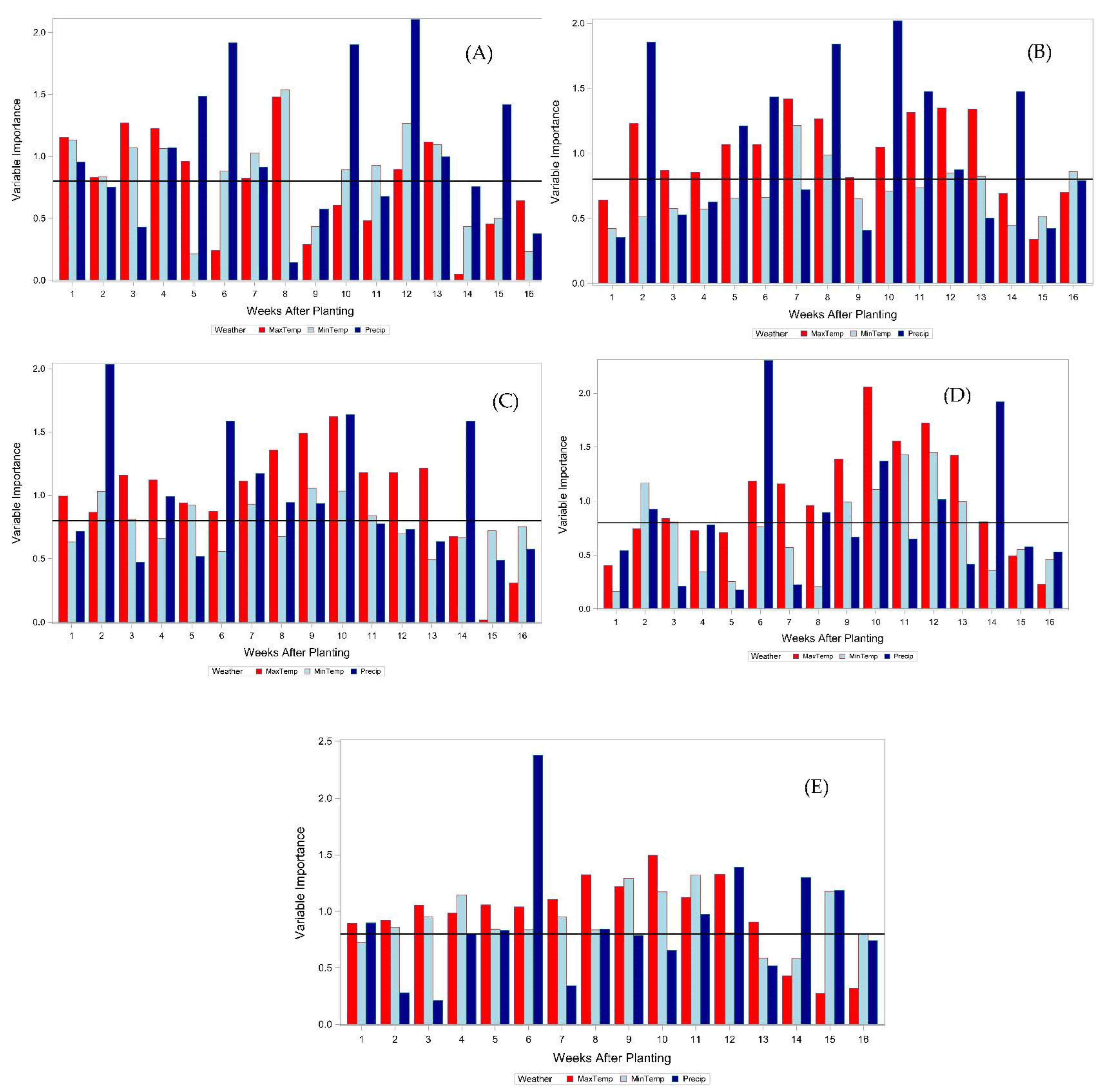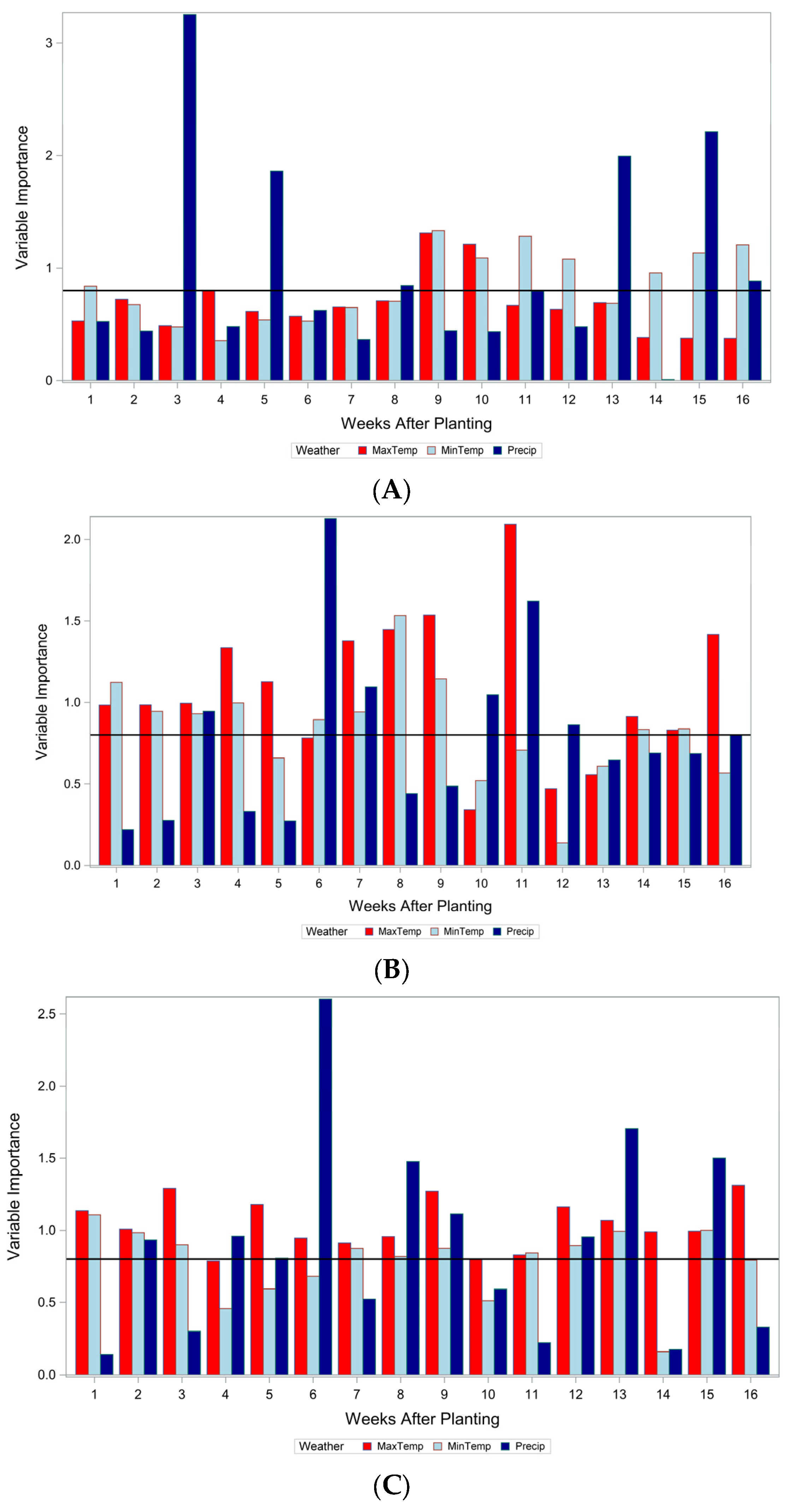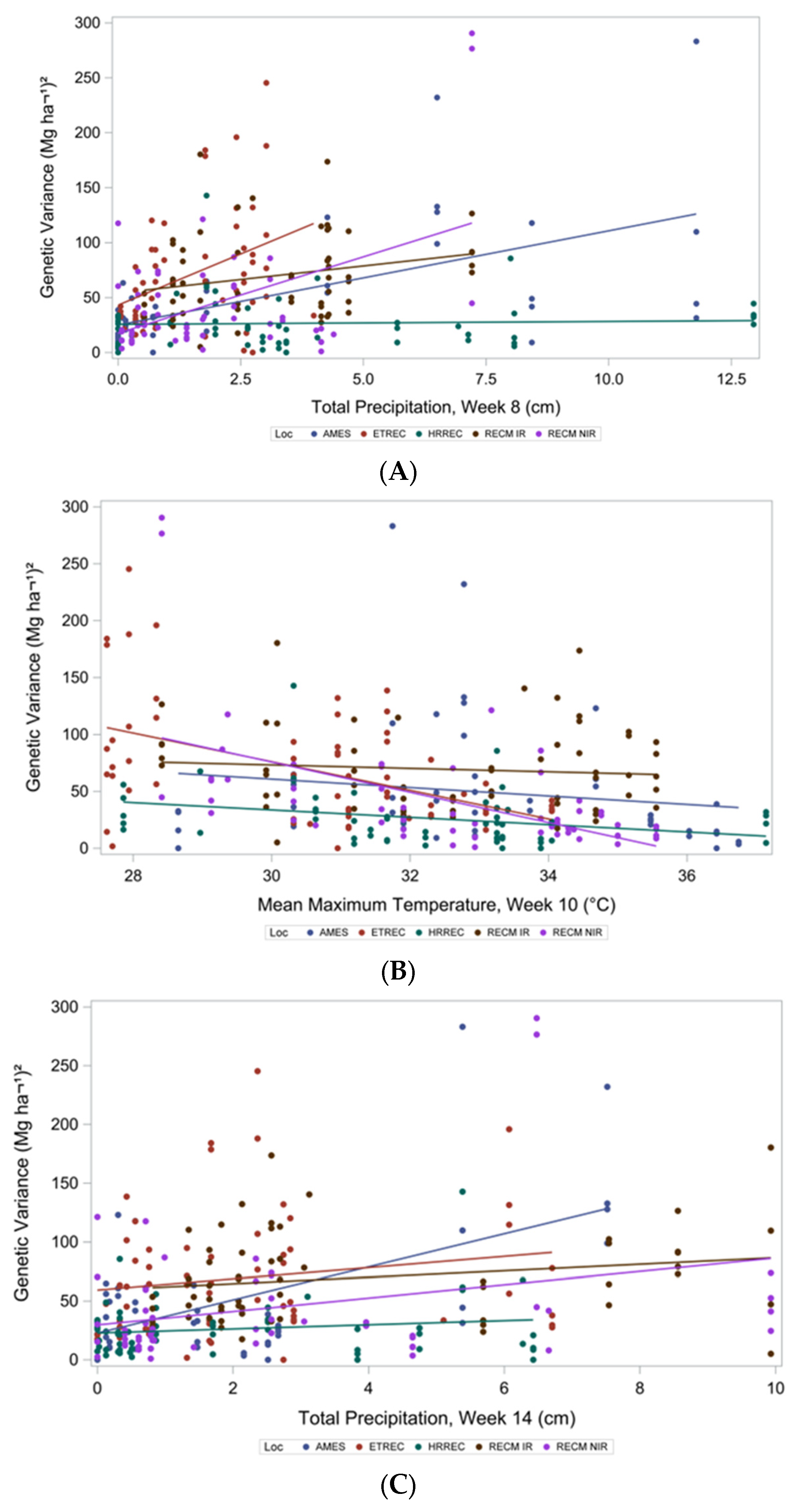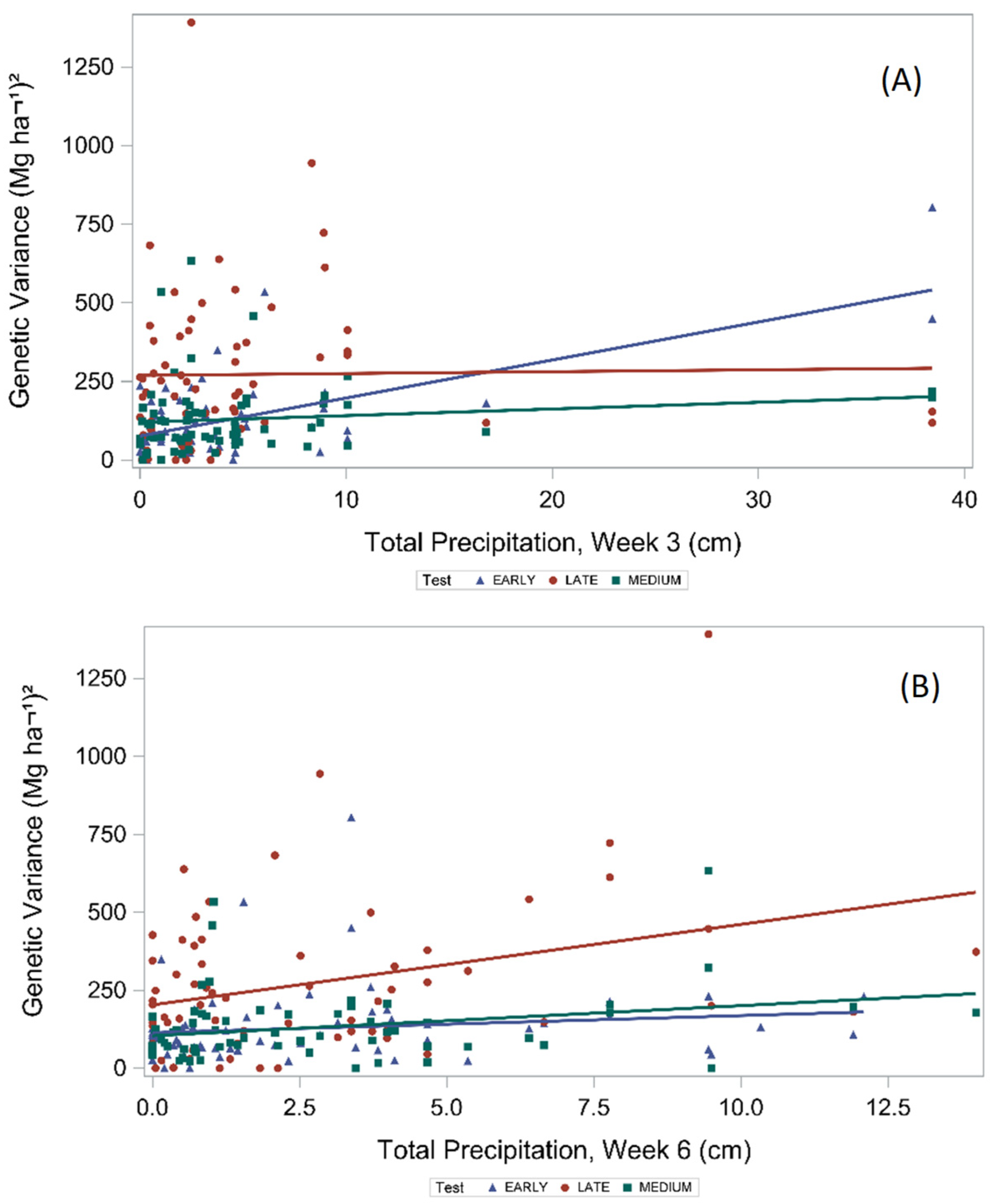Using Partial Least Squares and Regression to Interpret Temperature and Precipitation Effects on Maize and Soybean Genetic Variance Expression
Abstract
:1. Introduction
2. Materials and Methods
2.1. Data Sources
2.2. Statistical Methods
3. Results and Discussion
3.1. PLS Analyses of Weather Variables Explaining Vg in Soybean and Maize Maturity Groups
3.2. Regression Analyses of Weather Variables Explaining Vg in Soybean and Maize Maturity Groups
4. Conclusions
Author Contributions
Funding
Data Availability Statement
Acknowledgments
Conflicts of Interest
References
- Dia, M.; Wehner, T.C.; Hassell, R.; Price, D.S.; Boyhan, G.E.; Olson, S.; Juarez, B. Value of locations for representing mega-environments and for discriminating yield of watermelon in the U.S. Crop Sci. 2016, 56, 1726–1735. [Google Scholar] [CrossRef]
- Yates, F.; Cochran, W.U. The analysis of groups of experiments. J. Agric. Sci. 1938, 28, 556–580. [Google Scholar] [CrossRef]
- Finlay, K.W.; Wilkinson, G.N. The analysis of adaptation in a plant breeding programme. Aust. J. Agric. Res. 1963, 14, 742–754. [Google Scholar] [CrossRef]
- Gollob, H.F. A statistical model which combines features of factor analysis and analysis of variance techniques. Psychometrika 1969, 196833, 73–115. [Google Scholar] [CrossRef]
- Aastveit, H.; Martens, H. ANOVA interactions interpreted by partial least squares regression. Biometrics 1986, 42, 829–844. [Google Scholar] [CrossRef]
- Talbot, M.; Wheelwright, A.V. The analysis of genotype X environment interactions by partial least squares regression. Biul. Oceny Odmian 1989, 21/22, 19–25. [Google Scholar]
- Vargas, M.; Crossa, J.; Sayre, K.; Reynolds, M.; Ramírez, M.E.; Talbot, M. Interpreting Genotype × Environment Interaction in Wheat by Partial Least Squares Regression. Crop Sci. 1998, 38, 679–689. [Google Scholar] [CrossRef]
- Vargas, M.; Crossa, J.; van Eeuwijk, F.A.; Ramírez, M.E.; Sayre, K. Using Partial Least Squares Regression, Factorial Regression, and AMMI Models for Interpreting Genotype × Environment Interaction. Crop Sci. 1999, 39, 955–967. [Google Scholar] [CrossRef]
- Ashworth, A.J.; Knapp, K.V.; Allen, F.L.; Saxton, A.M. Comparing yield trial locations based on their elicited expressions of genetic variance among soybean cultivars. Crop Sci. 2020, 60, 313–1324. [Google Scholar] [CrossRef]
- Ashworth, A.J.; Knapp, V.; Allen, F.L.; Saxton, A.M. Comparison of discriminatory effects of maize yield test locations based on their genetic variation expression among hybrids. Crop Sci. 2020, 60, 3166–3174. [Google Scholar] [CrossRef]
- Wang, C.; Guo, L.; Li, Y.; Wang, Z. Systematic comparison of C3 and C4 plants based on Metabolic Network Analysis. BMC Syst. Biol. 2012, 6 (Suppl. 2), S9. [Google Scholar] [CrossRef]
- Van der Voet, H. Comparing the predictive accuracy of models using a simple randomization test. Chemom. Intell. Lab. Syst. 1994, 25, 313–323. [Google Scholar] [CrossRef]
- Parra-Quijano, M.; Draper, D.; Torres, E.; Iriondo, J.M. Ecogeographical representativensess in crop wild relative ex situ collections. In Crop Wild Relative Conservation and Use; Maxted, N., Ford-Lloyd, B.V., Kell, S.P., Iriondo, J.M., Dulloo, M.E., Turok, J., Eds.; CABI: Cambridge, MA, USA, 2007; pp. 249–273. [Google Scholar]
- Fehr, W.R.; Caviness, C.E. Stages of Soybean Development (Iowa State University Special Report No. 80); Iowa State University: Ames, IA, USA, 1977; Available online: https://dr.lib.iastate.edu/entities/publication/58c89bfe-844d-42b6-8b6c-2c6082595ba3 (accessed on 1 October 2023).
- Nielson, R.L. Maize growth and Development. What Goes on from Planting to Harvest. Purdue Univ. Ext. Pub. 2000, AGRY-97-07. Available online: https://www.agry.purdue.edu/ext/pubs/agry-97-07_v1-1.pdf (accessed on 1 October 2023).




| Test | All Variables | Precipitation Only | Max Temperature Only | Min Temperature Only |
|---|---|---|---|---|
| Soybean a | ||||
| CV5 | 50.7 | 42.3 | 23.7 | 16.7 |
| RR4E | 66.7 | 63.4 | 29.5 | 17.9 |
| RR4L | 68.4 | 71.7 | 28.0 | 11.8 |
| RR5E | 57.0 | 52.3 | 32.7 | 36.6 |
| RR5L | 51.6 | 38.8 | 19.6 | 27.6 |
| Average | 58.9 | 53.7 | 26.7 | 22.1 |
| Maize b | ||||
| Early | 53.9 | 54.6 | 20.1 | 32.0 |
| Medium | 38.1 | 22.8 | 31.8 | 15.3 |
| Late | 32.2 | 30.4 | 11.9 | 12.8 |
| Average | 41.4 | 35.9 | 21.2 | 20.03 |
| Source | DF | Type III SS | Mean Square | F Value | p-Value |
|---|---|---|---|---|---|
| MG Test a | 4 | 18,213 | 4553 | 3.12 | 0.016 |
| Location | 4 | 20,104 | 5026 | 3.45 | 0.009 |
| Precipitation Wk8 | 1 | 10,191 | 10,191 | 6.99 | 0.009 |
| Precipitation Wk8 × Location | 4 | 16,480 | 4120 | 2.83 | 0.025 |
| Precipitation Wk14 | 1 | 28,297 | 28,297 | 19.41 | 0.001 |
| Precipitation Wk14 × Location | 4 | 8639 | 2160 | 1.48 | 0.208 |
| Mean maximum temperature Wk10 | 1 | 22,848 | 22,848 | 15.68 | 0.001 |
| Mean maximum temperature Wk10 × Location b | 4 | 22,902 | 5726 | 3.93 | 0.004 |
| Error | 251 | 365,847 | 1458 |
| Weeks after Planting | Soybean | Maize |
|---|---|---|
| Approximate Stage of Growth 1 | Approximate Stage of Growth 2 | |
| 1 | VE: germination and emergence | VE: germination and emergence |
| 2 | VC: cotyledon-unifoliate leaves | V1: first leaf fully emerged |
| 3 | V1: one open trifoliate, nodules begin forming on roots, energy source transitions from cotyledons to photosynthesis | V2: two leaves fully emerged; plant relies on seed reserves for growth |
| 4 | V2–V3: 2–3 open trifoliates, lateral roots growing rapidly, nitrogen fixation underway through R6 | V3: three leaves, plant switches from seed reserves to photosynthesis, rapid nodal root development starts to occur |
| 5 | V4–V5: 4–5 fully opened trifoliates, rapid dry matter accumulation, flower buds begin to develop in leaf axils | V4–V5: nodal roots begin to take over, number of potential leaves and ear shoots are determined |
| 6 | V5–V6–R1–R2: rapid dry matter accumulation, flower bud growth, one or more open flowers at one of the two uppermost nodes | V6–V7: rapid growth stage, stem elongation begins |
| 7 | R2–R3: flower growth, pollination, pod growth | V8–V10: steady rapid growth and dry matter accumulation, tassel and ear shoots are developing |
| 8 | R2–R3: flower growth, pollination, pod growth | V9–V11: rapid growth, new leaves appear every 2–3 days |
| 9 | R3–R4: flower growth, pollination, pod growth and early seed development | V11–Vnth: brace roots are forming, potential kernel number per ear and ear size are being determined |
| 10 | R4–R5: rapid pod growth, seed beginning to fill | VT: tasseling, plants have reached full size |
| 11 | R4–R5: rapid pod growth, seed beginning to fill | R1: silking, pollen shed starts |
| 12 | R5–R6: rapid seed filling, nutrients and N being mobilized from plant parts to seed | R1–R2: silking, pollen shed, kernel blister stage |
| 13 | R5–R6: rapid seed filling, nutrients and N being mobilized from plant parts to seed | R2–R3: kernel blister and milk stage, grain dry matter accumulating |
| 14 | R5–R6: rapid seed filling, nutrients and N being mobilized from plant parts to seed | R3: kernel milk stage, grain dry matter accumulating |
| 15 | R6–R7: pods and seed are starting to mature and lose moisture | R3–R4: kernel milk and dough stage, grain dry matter accumulating |
| 16 | R6–R7: pods and seed are starting to mature and decrease in moisture | R5: kernel dent stage, grain is decreasing in moisture |
| Slope | Estimate | Standard Error | p-Value |
|---|---|---|---|
| Precipitation Wk 8 AMES b | 4.72 a,c,d | 1.88 | 0.012 |
| Precipitation Wk 8 ETREC | 1.61 abc | 6.59 | 0.806 |
| Precipitation Wk 8 HRREC | −0.09 b | 1.42 | 0.950 |
| Precipitation Wk 8 RECM IR | 6.75 ab | 3.48 | 0.053 |
| Precipitation Wk 8 RECM NIR | 9.26 ac | 2.96 | 0.002 |
| Precipitation Wk 14 AMES | 10.61 a | 3.12 | 0.001 |
| Precipitation Wk 14 ETREC | 5.23 ab | 2.76 | 0.060 |
| Precipitation Wk 14 HRREC | 1.93 b | 2.26 | 0.395 |
| Precipitation Wk 14 RECM IR | 3.18 b | 1.83 | 0.084 |
| Precipitation Wk 14 RECM NIR | 3.09 b | 1.94 | 0.113 |
| Mean maximum temperate Wk 10 AMES | −3.82 abc | 2.74 | 0.165 |
| Mean maximum temperate Wk 10 ETREC | −12.00 b | 3.52 | 0.001 |
| Mean maximum temperate Wk 10 HRREC | −3.11 ac | 2.33 | 0.183 |
| Mean maximum temperate Wk 10 RECM IR | 3.31 c | 3.09 | 0.284 |
| Mean maximum temperate Wk10 RECM NIR | −9.87 ab | 2.55 | 0.000 |
| Source | DF | Type III SS | Mean Square | F Value | Pr > F |
|---|---|---|---|---|---|
| MG test a | 2 | 309,177.40 | 154,588.70 | 6.59 | 0.002 |
| Location b | 4 | 397,117.02 | 99,279.26 | 4.24 | 0.003 |
| Precipitation Wk 3 | 1 | 125,803.35 | 125,803.35 | 5.37 | 0.022 |
| Precipitation Wk 3 × MG Test | 2 | 267,012.58 | 133,506.29 | 5.70 | 0.004 |
| Precipitation Wk 6 | 1 | 182,029.70 | 182,029.70 | 7.77 | 0.006 |
| Precipitation Wk 6 × MG Test | 2 | 174,945.61 | 87,472.80 | 3.73 | 0.026 |
| Error | 184 | 4,313,184.90 | 23,441.22 |
| Parameter | Estimate | Standard Error | p-Value d |
|---|---|---|---|
| Precipitation Wk 3, Early | 11.38 a,c,d | 2.82 | <0.001 |
| Precipitation Wk 3, Medium | 1.26 b | 2.79 | 0.654 |
| Precipitation Wk 3, Late | −1.19 b | 2.82 | 0.673 |
| Precipitation Wk 6, Early | 0.94 a | 6.19 | 0.879 |
| Precipitation Wk 6, Medium | 6.75 ab | 6.25 | 0.282 |
| Precipitation Wk 6, Late | 23.76 b | 6.32 | <0.001 |
Disclaimer/Publisher’s Note: The statements, opinions and data contained in all publications are solely those of the individual author(s) and contributor(s) and not of MDPI and/or the editor(s). MDPI and/or the editor(s) disclaim responsibility for any injury to people or property resulting from any ideas, methods, instructions or products referred to in the content. |
© 2023 by the authors. Licensee MDPI, Basel, Switzerland. This article is an open access article distributed under the terms and conditions of the Creative Commons Attribution (CC BY) license (https://creativecommons.org/licenses/by/4.0/).
Share and Cite
Ashworth, A.J.; Allen, F.L.; Saxton, A.M. Using Partial Least Squares and Regression to Interpret Temperature and Precipitation Effects on Maize and Soybean Genetic Variance Expression. Agronomy 2023, 13, 2752. https://doi.org/10.3390/agronomy13112752
Ashworth AJ, Allen FL, Saxton AM. Using Partial Least Squares and Regression to Interpret Temperature and Precipitation Effects on Maize and Soybean Genetic Variance Expression. Agronomy. 2023; 13(11):2752. https://doi.org/10.3390/agronomy13112752
Chicago/Turabian StyleAshworth, Amanda J., Fred L. Allen, and Arnold M. Saxton. 2023. "Using Partial Least Squares and Regression to Interpret Temperature and Precipitation Effects on Maize and Soybean Genetic Variance Expression" Agronomy 13, no. 11: 2752. https://doi.org/10.3390/agronomy13112752
APA StyleAshworth, A. J., Allen, F. L., & Saxton, A. M. (2023). Using Partial Least Squares and Regression to Interpret Temperature and Precipitation Effects on Maize and Soybean Genetic Variance Expression. Agronomy, 13(11), 2752. https://doi.org/10.3390/agronomy13112752







